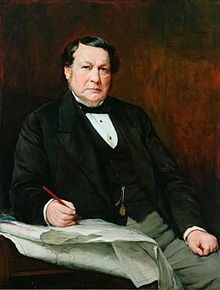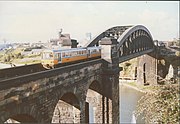Thomas Elliot Harrison
Thomas Elliot Harrison | |
|---|---|
 T.E. Harrison painted by Walter William Ouless c.1884 | |
| Born | 4 April 1808 |
| Died | 20 March 1888 (aged 79) Whitburn, Sunderland, County Durham, England |
| Occupation | Engineer |
Thomas Elliot Harrison (4 April 1808 – 20 March 1888) was an English engineer. Born in Fulham, London, he was raised in the north east of England, where his father was a promoter of early railway companies; after an apprenticeship under William Chapman; he gained engineering experience on the lines his father had helped establish, as well as in working in association with George Stephenson and Robert Stephenson during his early career.
In 1850 he became chief engineer of the
The best known works he was involved with are bridges: which include the
He died in 1888, at home in Whitburn, Sunderland, County Durham whilst still working for the North Eastern Railway.
Biography
Thomas Elliot Harrison was born in
He completed his apprenticeship in 1829, and travelled to London seeking work. Unsuccessful in obtaining a civil-engineering position, he spent a year working as an accountant's assistant.[3] In 1830 and 1831 he was employed by
He remained as chief engineer of the NER for the rest of his life, overseeing its continued growth through mergers and through the construction of new lines. Notable works included the planning or design of: the
In addition to his work as part of the NER he was seventeenth president of the Institution of Civil Engineers from 1873 to 1875,[17] served on the Royal Commission for the Water-supply of London (1867–69),[18] and was successful and respected as an expert witness and consultant engineer, from his work as a parliamentary witness he earned the nickname 'Honest Tom'.[19]
He was not notable as a mechanical engineer, and only slowly accepted the value of the
He lived at
He left seven children from two marriages.[1]
Works
References
- ^ a b c d e Brooke 2004.
- ^ Obituary, Min. Proc. Inst. Civ. Eng pp.301–2
- ^ Obituary, Min. Proc. Inst. Civ. Eng p.302
- ^ Obituary, Min. Proc. Inst. Civ. Eng p.303
- ^ Tomlinson 1915, pp. 212–3.
- ^ Tomlinson 1915, p. 214.
- ^ Tomlinson 1915, p. 227.
- ^ Tomlinson 1915, p. 318.
- ^ Tomlinson 1915, p. 516.
- ^ Tomlinson 1915, p. 518, 549.
- ^ Obituary, Min. Proc. Inst. Civ. Eng pp.304–5
- ^ MacDermot 1927, pp. 741–5, 746–8.
- ^ Tomlinson 1915, p. 634.
- ^ Tomlinson 1915, pp. 634–6.
- ^ a b c Obituary, Min. Proc. Inst. Civ. Eng pp.305–8
- ^ Tomlinson 1915, p. 685.
- ^ Past Presidents, Institution of Civil Engineers, archived from the original on 29 March 2015
- ^ Obituary, Min. Proc. Inst. Civ. Eng p.311
- ^ Obituary, Min. Proc. Inst. Civ. Eng pp.310–1
- ^ Tomlinson 1915, p. 649.
- ^ Obituary, Min. Proc. Inst. Civ. Eng pp.311–2
Sources
- "Obituary. Thomas Elliot Harrison, 1808–1888", Minutes of the Proceedings, 94 (1888), Institute of Civil Engineers: 301–313, 1888,
- Brooke, David (2004). "Thomas Harrison". doi:10.1093/ref:odnb/12452. (Subscription or UK public library membershiprequired.)
- MacDermot, E.T. (1927), History of the Great Western Railway, vol. I: 1833–1863, Paddington: Great Western Railway
- Tomlinson, William Weaver (1915), The North Eastern Railway; its rise and development, Andrew Reid and Company, Newcastle; Longmans, Green and Company, London
Literature
- Addyman, John; Fawcett, Bill (2008), Thomas Elliot Harrison (1808 -1888) Founder and Engineer of the North Eastern Railway, ISBN 9780953516230
- Wododward, G. (2001), "Trubshaw, Hartley and Harrison Early Nineteenth Century Engineers and Architects", Transactions of the Newcomen Society, 72A: 77–90, archived from the original on 24 September 2015
External links
- "Thomas Elliot Harrison", steamindex.com biography and literature



